Published online by Cambridge University Press: 21 May 2019

Daniel A. Segal is the Jean M. Pitzer Professor of Anthropology and a professor of history at Pitzer College of the Claremont Colleges. His most recent scholarly publication is Daniel A. Segal, “Witnessing Chimpanzee–Human Closeness: Jane Goodall at Gombe and Since,” Anthropological Quarterly 90, no. 4 (2017): 1189–1235, https://muse.jhu.edu/article/686173/pdf. He recently published an op-ed on why Pitzer College faculty voted to suspend a study-abroad program in Haifa, Israel: Segal, “Why Israel?,” Inside Higher Ed, January 21, 2019, accessed February 26, 2019, https://www.insidehighered.com/views/2019/01/21/why-faculty-pitzer-college-voted-suspend-study-abroad-program-israel-opinion.
2 Brenneis, Donald, Shore, Cris, and Wright, Susan, “Getting the Measure of Academia: Universities and the Politics of Accountability,” Anthropology in Action 12, no. 1 (2005): 1–10CrossRefGoogle Scholar; Strathern, Marilyn, ed., Audit Cultures: Anthropological Studies in Accountability, Ethics, and the Academy (London: Routledge, 2000)Google Scholar.
3 On generational shifts among U.S. Jews in regard to Israel, see Beinart, Peter, “The Failure of the American Jewish Establishment,” The New York Review of Books (June 10, 2010).
4 The use of “suspension” in this essay came about fortuitously, albeit with twists and turns. As I taught about Palestine-Israel in the fall of 2018, I also introduced a proposal for Faculty Meeting at Pitzer College, in regard to our one approved study-abroad program in Israel, at the University of Haifa. In the working draft of that proposal, I had written a call to “end” the program, but just before sending the proposal out to the Faculty, I thought better of that and adopted the term “suspend” until specific conditions had been met. Then, on February 6, 2019, Claremont SJP sponsored a panel of outside speakers at Pitzer in support of the motion. In that context, Mark Minch-de Leon gave an incisive short talk on the value of “suspension” as a political strategy – as a way to disrupt “business as normal” in regard to normalized evil. A few weeks later, when I sat down to draft this text, Mark's comments, still fresh in my memory, led me to add “and suspension” to what I had previously thought of as a “pedagogy of delay.”
5 A useful short text in this regard, which I have had my students read as an in-class assignment, is Paul Krugman, “The Centrist Cop-Out,” The New York Times (July 29, 2011).
6 DuBois, W.E.B., “The Concept of Race,” chapter 5 in Dusk of Dawn: An Essay Toward an Autobiography of a Race Concept” (Oxford: Oxford University Press, 1940)Google Scholar; Morgan, Edmund, “Slavery and Freedom: the American Paradox,” Journal of American History, 59, no. 1 (1972): 5–29CrossRefGoogle Scholar; Fields, Barbara, “Ideology and Race in American History” in Region, Race, and Reconstruction: Essays in Honor of C. Vann Woodward, eds. Kousser, J. Morgan and McPherson, James M. (New York: Oxford University Press, 1982), 143–77Google Scholar; Fields, Barbara, “Slavery, Race and Ideology in the United States of America, New Left Review, 181 (May–June 1990)Google Scholar; Handler, Richard and Segal, Daniel, “Cultural Approaches to Nationalism,” in The Sage Handbook of Nations and Nationalism, eds. Delanty, Gerard and Kumar, Krishnan (London: Sage Publications, 2006), 57–65Google Scholar.
7 Sand, Shlomo, The Invention of the Jewish People (New York: Verso Books, 2009)Google Scholar.
8 Pomeranz, Kenneth and Segal, Daniel, “Troubled Partitions,” in A World History, A Human History (in preparation)Google Scholar.
9 Relevant here is that along with Arabs and Jews, we also find Arab Jews; see, for example Levy, Lital, “Historicizing the Concept of Arab Jews in the Mashriq,” The Jewish Quarterly Review 98, no. 4 (2008): 452–69CrossRefGoogle Scholar.
10 My thinking about “beginnings” has been jump-started, in a sense, by both Said, Edward, Beginnings: Intentions and Method (New York: Columbia University Press, 1985)Google Scholar and Roth, Phillip, Portnoy's Complaint (New York: Random House, 1967), particularly 274Google Scholar.